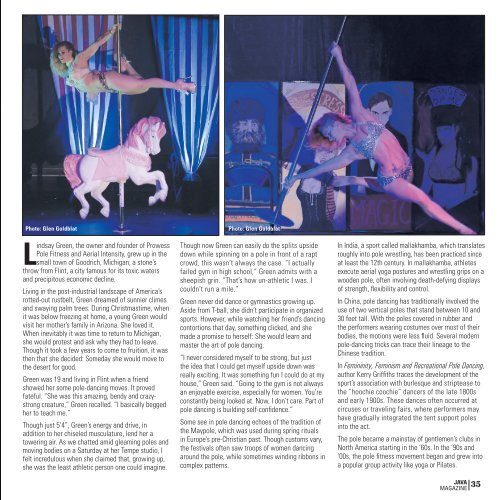JAVA.June.2018
Create successful ePaper yourself
Turn your PDF publications into a flip-book with our unique Google optimized e-Paper software.
Photo: Glen Goldblat<br />
Lindsay Green, the owner and founder of Prowess<br />
Pole Fitness and Aerial Intensity, grew up in the<br />
small town of Goodrich, Michigan, a stone’s<br />
throw from Flint, a city famous for its toxic waters<br />
and precipitous economic decline.<br />
Living in the post-industrial landscape of America’s<br />
rotted-out rustbelt, Green dreamed of sunnier climes<br />
and swaying palm trees. During Christmastime, when<br />
it was below freezing at home, a young Green would<br />
visit her mother’s family in Arizona. She loved it.<br />
When inevitably it was time to return to Michigan,<br />
she would protest and ask why they had to leave.<br />
Though it took a few years to come to fruition, it was<br />
then that she decided: Someday she would move to<br />
the desert for good.<br />
Green was 19 and living in Flint when a friend<br />
showed her some pole-dancing moves. It proved<br />
fateful. “She was this amazing, bendy and crazystrong<br />
creature,” Green recalled. “I basically begged<br />
her to teach me.”<br />
Though just 5’4”, Green’s energy and drive, in<br />
addition to her chiseled musculature, lend her a<br />
towering air. As we chatted amid gleaming poles and<br />
moving bodies on a Saturday at her Tempe studio, I<br />
felt incredulous when she claimed that, growing up,<br />
she was the least athletic person one could imagine.<br />
Photo: Glen Goldblat<br />
Though now Green can easily do the splits upside<br />
down while spinning on a pole in front of a rapt<br />
crowd, this wasn’t always the case. “I actually<br />
failed gym in high school,” Green admits with a<br />
sheepish grin. “That’s how un-athletic I was. I<br />
couldn’t run a mile.”<br />
Green never did dance or gymnastics growing up.<br />
Aside from T-ball, she didn’t participate in organized<br />
sports. However, while watching her friend’s dancing<br />
contortions that day, something clicked, and she<br />
made a promise to herself: She would learn and<br />
master the art of pole dancing.<br />
“I never considered myself to be strong, but just<br />
the idea that I could get myself upside down was<br />
really exciting. It was something fun I could do at my<br />
house,” Green said. “Going to the gym is not always<br />
an enjoyable exercise, especially for women. You’re<br />
constantly being looked at. Now, I don’t care. Part of<br />
pole dancing is building self-confidence.”<br />
Some see in pole dancing echoes of the tradition of<br />
the Maypole, which was used during spring rituals<br />
in Europe’s pre-Christian past. Though customs vary,<br />
the festivals often saw troops of women dancing<br />
around the pole, while sometimes winding ribbons in<br />
complex patterns.<br />
In India, a sport called mallakhamba, which translates<br />
roughly into pole wrestling, has been practiced since<br />
at least the 12th century. In mallakhamba, athletes<br />
execute aerial yoga postures and wrestling grips on a<br />
wooden pole, often involving death-defying displays<br />
of strength, flexibility and control.<br />
In China, pole dancing has traditionally involved the<br />
use of two vertical poles that stand between 10 and<br />
30 feet tall. With the poles covered in rubber and<br />
the performers wearing costumes over most of their<br />
bodies, the motions were less fluid. Several modern<br />
pole-dancing tricks can trace their lineage to the<br />
Chinese tradition.<br />
In Femininity, Feminism and Recreational Pole Dancing,<br />
author Kerry Griffiths traces the development of the<br />
sport’s association with burlesque and striptease to<br />
the “hoochie coochie” dancers of the late 1800s<br />
and early 1900s. These dances often occurred at<br />
circuses or traveling fairs, where performers may<br />
have gradually integrated the tent support poles<br />
into the act.<br />
The pole became a mainstay of gentlemen’s clubs in<br />
North America starting in the ’60s. In the ’90s and<br />
’00s, the pole fitness movement began and grew into<br />
a popular group activity like yoga or Pilates.<br />
<strong>JAVA</strong> 35<br />
MAGAZINE


















